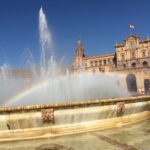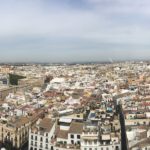At the beginning of October, the entire Holy Cross group flew to Andalusía, on the Southern coast of Spain, stopping in Sevilla and Granada.
While in Sevilla, we toured the Cathedral de Sevilla, the (alleged) site of Christopher Columbus’ tomb and a bell tower called the Giralda, at the top of which there is a view of the entire city. We spent time in the Plaza de España and the Alcazar, the royal palace built for King Peter of Castilla. We also went to a rooftop bar, saw a flamenco show, and spent a night at the International Fair, where there were huge tents serving food and drinks from many different countries (very overwhelming and fun!).
In Granada, we spent a lot of time roaming the street markets, where we were able to see the Moorish influence on the designs of the beautiful handmade colored lamps, scarves, and jewelry that were being sold in almost every store. We also did a 3 hour long walking tour of La Alhambra (all of the palaces, the gardens, and the fort) and the Generalife, the leisure patio to which the Nasrid rulers escaped when they wanted to get away from the palace. Our tour guide made sure that we noticed how different the Generalife is from the rest of La Alhambra–instead of the totally enclosed gardens surrounding the large ponds (the Moorish ideal garden) that characterize all of the other patios, the Generalife is more open and contains a single, much smaller fountain.
My favorite part of our trip to Granada was our tour of Sacromonte, Granada’s gypsy community. It is located in the very hilly countryside and it takes a decent amount of walking to find it. The gypsies are thought to have settled in Granada after the expulsion of the Moors by Ferdinand and Isabella in 1492. Gypsy families lived in caves, alongside the livestock that they used to make a living. There is still a sizable gypsy community there, and even though the gypsies don’t live extremely far from the center of the city, they have a way of life and sense of community that is very separate from Granada (our tour guide quipped that they also have an independent government system/follow their own set of laws). However, when I asked our tour guide if the gypsies dislike that tourists are constantly coming in and out of their barrio, he said that they don’t mind it because they make their money off of tourism (I guess there is a delicate balance between their independent lifestyle and their level of interaction with outsiders).
Our tour guide took us to a bar run by a man from the gypsy community, who has become our tour guide’s friend over the years. The bar is located inside of a cave, but the view from the patio was amazing.
There were SO many tourists in both cities, especially in Sevilla. Southern Spain is obviously a lot warmer than northern Spain, but I still find it interesting that historical, culturally distinct regions like Galicia don’t get more tourists each year. I think that a lot of tourists have a fixed, narrow idea of what Spain is, and places like Sevilla and Granada are the cities that best fit within that narrative.
I know that my rambling about the number of tourists in Spain is ironic. But traveling to these more touristy regions showed me how lucky I am to be studying in a region that, to me, feels like a hidden gem. Coruña has beautiful ocean views and is a busy and vivacious city where there is always something happening–but you never see tourists or hear English being spoken.
I am already more than half-way into first semester (time has flown by!!), and I feel so grateful for the authentic, fully immersive cultural learning experience I have had thus far.
I am able to authentically explore all that Coruña and Galician culture have to offer because I attend a Spanish university, have some Spanish friends, and live in the center of the city with my host parents and three host sisters. It’s not likely that I will ever have another opportunity to visit another country and be as immersed in a different language and culture as I am right now.
I love when experiences provide broader perspectives. 🙂



























